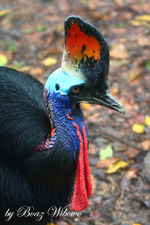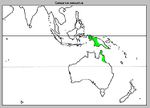Cassowary
| Cassowary |
|---|

|
| Scientific Classification |
|
| species casuarius |
|

|
| Adult southern cassowary (double waddled cassowary) |
Cassowary are species of flightless birds that are classified as an endangered species. There has been three different species recorded. the dwarf cassowary, Southern, and northern cassowary (also known as double waddled cassowary). They are mainly found in Australia and the island of new genie. They aren't social birds and will survive individually, only meeting up for mating and when food is scarce. Their diet mainly consists of fruits and plants. When mating season occurs it's unusually the female that takes care of the chicks, because only the male cassowary cares for them. Sometimes the female is known to try and kill her own young.
Body Design
The cassowary is a flightless bird with a thick two-quilled feathers. These feather are jet black and are used for protection against their harsh habitats in the forest. Like thorns, weather, and keeping them warm and dry. When fully grown they have a jet black appearance with a blue neck and a red waddle. When the are first born the are black and tan striped. On the cassowary's head is a casque. This casque is made of a sponge like material and covered with a thick layer of keratin. Keratin is what our fingernails are made of. they are rough and hard on the outer edge of the casque, but as you progress towards the middle they are quite soft.[1]
When fully grown they are 2 meters tall and weigh about 60 kilograms. The male and female are hard to distinguish apart since they are very similar in appearance. Although they are similar, the female is larger than the males and appear more vibrant in color. The cassowary has tiny wings that serve no purpose to the bird. On these wings they have long mortified quills (like a porcupines) that curve around the body. The cassowary has huge amber color eyes facing forward, while most birds have eyes facing sideways. Cassowaries have long scaly legs with three toes, the middle being the biggest. On each of these toes are long (about) 5 inch talons that they use for fighting and defending themselves.[2]
Life Cycle
Cassowary's lifespan in captivity range from 40-60 years, and it is unknown in the wild. Other than mating season, they rarely interact with each other. They are very territorial and with defend its food source when food becomes scarce. Mating season occurs in the winter and spring. The female starts mating at 3.5 years, the males can be a year younger (2.5 years). The female lays 3-5 large eggs in a protective ring made of twigs, rocks, and leaves that the male made. What's very different about the female is that they don't care for the chicks at all, it is the male who cares for their offspring. When given the chance, the female will kill the chicks. The chicks will be cared for up until 18 months where they will leave or be chased away by the male to fend for themselves. they are most vulnerable at this stage in life.[3]
Cassowaries are an endangered species, estimated to be about 2,000 left in the world. They are mainly killed due to road activity and threatened by feral and pet dogs. They are very deadly and can kill people, but will run away if possible. They can run up to 50 mph and jump about 2 meters (6ft) high. When food becomes scarce they will for little packs and defend the food until it is abundant. They're main diet consists of fruit, but when hungry they will eat just about anything.[4]
Ecology
Cassowaries habitat range is mainly consists of rain forests and can also be seen on beaches adjacent to these conditions. They live in the islands of New Guanine and the coast of Australia. They play a key role to the rain forests ecology, helping spread the seeds all across the land. They're digestive tract is gentle to the fruit, making the seeds ready for germination and the waste provide as a good fertilizer for the plant. This makes them known as a "keystone species", helping maintain diversity and balance throughout the rain forest. They are known to enter farm lands when food becomes scarce and require clean water for drinking and bathing.[5]
The cassowaries diet mainly consist of soft fruit, berries, and plants. They have been classified as frugivorous (fruit-eating), but have been known for eating small vertebrates, invertebrates, and fungi when food becomes scarce. When desperate and starving cassowaries will eat soil for the minerals it provides. over 238 species of plants have been recorded in their diet. They have a gentle digestive system, leaving the seeds unharmed.[6]
how dangerous they can be
cassowary's have been classified as some of the most dangerous birds and animals. They are very defensive, especially when they have babies with them. they are easily provoke and will attack when threatened. Zoo keepers have found it hard to maintain these birds, usually getting hurt in some way during the process. there are 3 main ways they can kill and defend themselves. First, if you ever provoked one they will chase you down, running up to 50mph. Second, the have 12cm long talons that and really cause damage with one good kick. Finally, they can jump about 1 meter. Even though they are deadly, they are an endangered species. most of it is form people and road activities and people cutting down fruit trees that provide their main food source.
Video
this is an animal documentary about the cassowary
Gallery
References
- ↑ cassowary San Diego Zoo. Web. April 27, 2018. author unknown
- ↑ . Cassowary (Southern Cassowary) panique.com. Web. april 13, 2018. (opened)
- ↑ . Life History cassowary recovery team. Web. April 13,2018. (opened) author unknown
- ↑ . Cassowaries kuranda envirocare. Web. April 14,2018. (opened) author unknown
- ↑ Webpub Media Solutions. ecology&habitat rain forest rescue. Web. April 15, 2018 (opened)
- ↑ . Diet and Ecology cassowaryrecoveryteam. Web. April 28, 2018 (opened)





